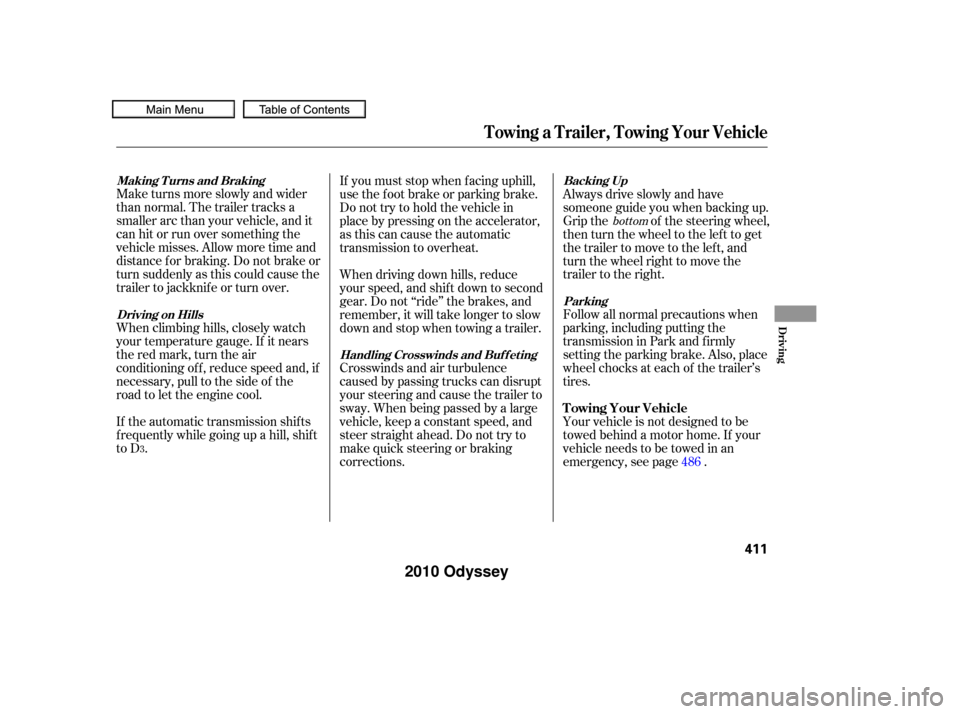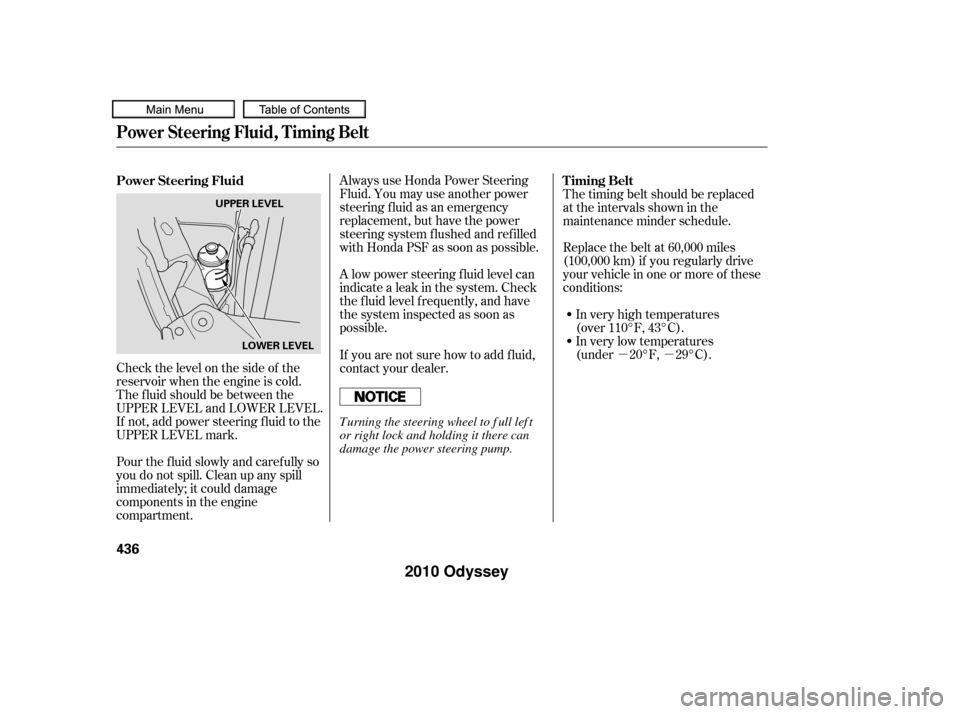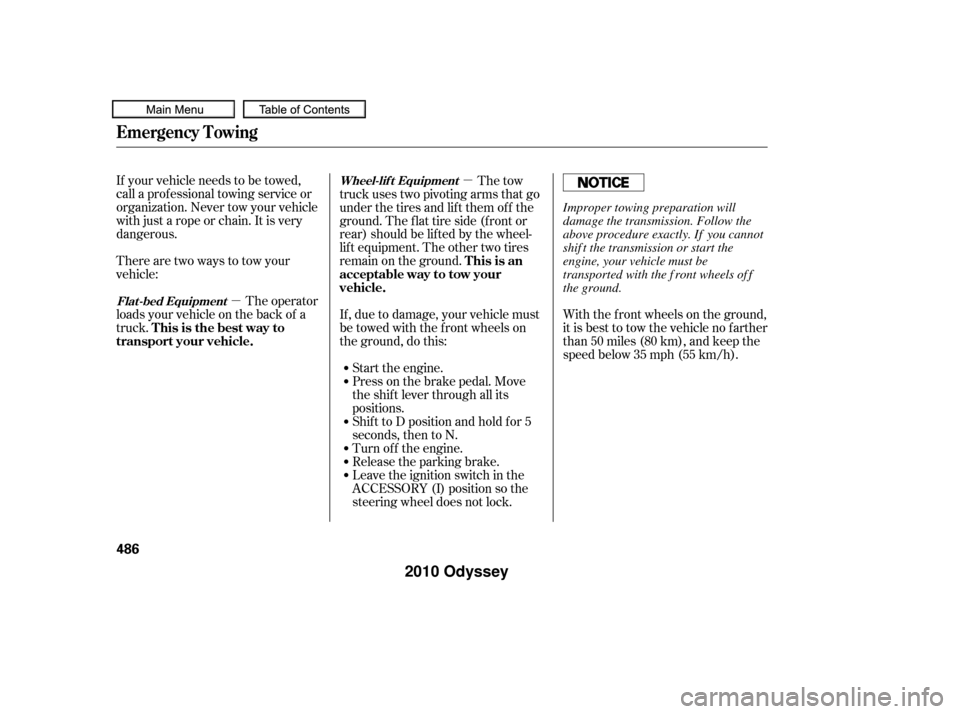Page 414 of 526

Maketurnsmoreslowlyandwider
than normal. The trailer tracks a
smaller arc than your vehicle, and it
canhitorrunoversomethingthe
vehicle misses. Allow more time and
distance f or braking. Do not brake or
turn suddenly as this could cause the
trailer to jackknif e or turn over.
When climbing hills, closely watch
your temperature gauge. If it nears
the red mark, turn the air
conditioning of f , reduce speed and, if
necessary, pull to the side of the
road to let the engine cool.
If the automatic transmission shif ts
f requently while going up a hill, shif t
to D .Always drive slowly and have
someone guide you when backing up.
Grip the of the steering wheel,
then turn the wheel to the left to get
the trailer to move to the lef t, and
turn the wheel right to move the
trailer to the right.
Follow all normal precautions when
parking, including putting the
transmission in Park and f irmly
setting the parking brake. Also, place
wheel chocks at each of the trailer’s
tires.
If you must stop when f acing uphill,
use the f oot brake or parking brake.
Do not try to hold the vehicle in
placebypressingontheaccelerator,
as this can cause the automatic
transmission to overheat.
When driving down hills, reduce
your speed, and shif t down to second
gear. Do not ‘‘ride’’ the brakes, and
remember, it will take longer to slow
downandstopwhentowingatrailer.
Crosswinds and air turbulence
caused by passing trucks can disrupt
your steering and cause the trailer to
sway. When being passed by a large
vehicle, keep a constant speed, and
steer straight ahead. Do not try to
make quick steering or braking
corrections.
Your vehicle is not designed to be
towed behind a motor home. If your
vehicle needs to be towed in an
emergency, see page .
486
3
bottom
Making T urns and Braking
Driving on Hills Backing Up
Parking
Handling Crosswinds and Buf f et ing
Towing a Trailer, Towing Your Vehicle
Towing Your Vehicle
Driving
411
�����—�����—�
���y�
�������������y���
�(�����������y�����
���y
2010 Odyssey
Page 416 of 526

This section explains why it is
important to keep your vehicle well
maintained and how to f ollow basic
maintenance saf ety precautions.
This section also includes
instructions on how to read the
maintenance minder messages on
the inf ormation display or multi-
inf ormation display (depending on
models), and instructions f or simple
maintenance tasks you may want to
take care of yourself .
If you have the skills and tools to
perf orm more complex maintenance
tasks on your vehicle, you may want
to purchase the service manual. See
page f or inf ormation on how to
obtain a copy, or see your dealer.......................
Maintenance Saf ety .414
....................
Maintenance Minder . 415
..............................
Fluid Locations .425
........................
Adding Engine Oil .426
Changing the Engine Oil and ...........................................
Filter .428
..............................
Engine Coolant .430
....................
Windshield Washers .432
....
Automatic Transmission Fluid . 433
....................................
Brake Fluid .435
....................
Power Steering Fluid . 436
....................................
Timing Belt .436
.............................................
Lights .437
................
Cleaning the Seat Belts . 444
.....................................
Floor Mats .444
..................
Dust and Pollen Filter . 444
.................................
Wiper Blades .445
...........................................
Wheels .450
...............................................
Tires .450
...................
Checking the Battery . 458
.............................
Vehicle Storage .459
511
Maintenance
Maint enance
413
�����—�����—�
���y�
�������������y���
�(�����������y�����
���y
2010 Odyssey
Page 420 of 526
�µ
CONT INUED
If you still do not perf orm the
indicated maintenance, you will see a
negative mileage, f or example
‘‘ 543,’’ blinking in the display. This
negative mileage means that you
should have perf ormed the indicated
maintenance 543 miles ago.
Immediately have the indicated
maintenancedonebyyourdealer.When the remaining engine oil lif e is
15 percent or less, the display shows
a ‘‘SERVICE DUE SOON’’ message
along with the maintenance item
code(s) f or other scheduled
maintenance items needing service.
To see the current engine oil lif e,
turn the ignition switch to the ON
(II) position, then push and release
the SEL/RESET button on the
steering wheel repeatedly, until the
engine oil lif e is displayed.
When you turn the ignition switch to
the ON (II) position, the system
message indicator will also come on.
On Touring models
Maintenance Minder
Maint enance
417
SYSTEM MESSAGE INDICATOR
�����—�����—�
���y�
�������������y���
�(�����������y���������y
2010 Odyssey
Page 421 of 526
These messages will come on every
time you turn the ignition switch to
the ON (II) position.
Immediately have the service
perf ormed, and make sure to reset
the display as described on page .
You can change the display to the
odometer, the trip meter, or the
outside temperature by pushing the
SEL/RESET button on the steering
wheel.
When the remaining engine oil lif e is
less than 5 percent, you will see the
above display. The display then
changes to ‘‘SERVICE DUE NOW.’’
Have the indicated maintenance
done as soon as possible. When the remaining engine oil lif e is
less than 0 percent and you have not
done the required maintenance, you
will see the above display for several
seconds. In this display, ‘‘0’’ will be
blinking.
The display then changes to
‘‘SERVICE PAST DUE.’’ 421
Maintenance Minder
418
�����—�����—�
���y�
�������������y���
�(�����������y���������y
2010 Odyssey
Page 424 of 526
Press the SEL/RESET button on
the steering wheel. The
maintenance item code(s) will
disappear, and the engine oil lif e
will reset to ‘‘100.’’If you want to cancel resetting,
presstheINFObuttononthe
steering wheel. The display
changesasshown.PresstheSEL/
RESET button. This cancels the
resetting procedure, and the
screen returns to the normal
display mode.
Press the SEL/RESET button on
the steering wheel f or about 10
seconds. The display will change
to the ‘‘CUSTOM SETUP’’ mode.
Turn the ignition switch to the ON
(II) position.
Press the SEL/RESET button on
the steering wheel until you see
the engine oil lif e display.
3.
1.
2.
4.5.
CONT INUED
On Touring models
Maintenance Minder
Maint enance
421
�����—�����—�
���y�
���������
���y���
�(�����������y���������y
2010 Odyssey
Page 439 of 526

�µ�µ
Always use Honda Power Steering
Fluid. You may use another power
steering f luid as an emergency
replacement, but have the power
steering system f lushed and ref illed
with Honda PSF as soon as possible.
A low power steering f luid level can
indicate a leak in the system. Check
the f luid level f requently, and have
the system inspected as soon as
possible.
Replace the belt at 60,000 miles
(100,000 km) if you regularly drive
your vehicle in one or more of these
conditions:
In very high temperatures
(over 110°F, 43°C).
In very low temperatures
(under 20°F, 29°C).
Check the level on the side of the
reservoir when the engine is cold.
The f luid should be between the
UPPER LEVEL and LOWER LEVEL.
If not, add power steering f luid to the
UPPER LEVEL mark. The timing belt should be replaced
at the intervals shown in the
maintenance minder schedule.
Pour the f luid slowly and caref ully so
you do not spill. Clean up any spill
immediately; it could damage
components in the engine
compartment. If you are not sure how to add f luid,
contact your dealer.
Power Steering Fluid
T iming Belt
Power Steering Fluid, Timing Belt
436
UPPER LEVEL
LOWER LEVEL
Turning the steering wheel to f ull lef t
or right lock and holding it there can
damage the power steering pump.
�����—�����—�
���y�
�������������y���
�(�����������y�������
�y
2010 Odyssey
Page 457 of 526

Replace your tires with radial tires of
the same size, load range, speed
rating, and maximum cold tire
pressure rating (as shown on the
tire’s sidewall).
Mixing radial and bias-ply tires on
your vehicle can reduce braking
ability, traction, and steering
accuracy. Using tires of a dif f erent
size or construction can cause the
ABS and vehicle stability assist
system (VSA) to work inconsistently.
The ABS and VSA system work by
comparing the speed of each wheel.
When replacing tires, use the same
size originally supplied with the
vehicle. Tire size and construction
can af f ect wheel speed and may
cause the system to activate.Replacement wheels are available at
your dealer.
It is best to replace all f our tires at
thesametime.If thatisnotpossible
or necessary, replace the two f ront
tires or two rear tires as a pair.
Replacing just one tire can seriously
af f ect your vehicle’s handling.
If you ever replace a wheel, make
sure that the wheel’s specif ications
match those of the original wheels.
Also be sure you use only TPMS
specif ic wheels. If you do not, the
tire pressure monitoring system will
not work.
Tires
Replacing T ires and Wheels
454
Installing improper tires on your
vehicle can affect handling and
stability. This can cause a crash
in which you can be seriously
hurt or killed.
Always use the size and type of
tires recommended in this
owner’s manual.
�����—�����—�
���y�
�������������y���
�(�����������y���������y
2010 Odyssey
Page 489 of 526

�µ�µ
If your vehicle needs to be towed,
call a prof essional towing service or
organization. Never tow your vehicle
with just a rope or chain. It is very
dangerous.
Therearetwowaystotowyour
vehicle:
With the f ront wheels on the ground,
it is best to tow the vehicle no farther
than 50 miles (80 km), and keep the
speedbelow35mph(55km/h).
The operator
loads your vehicle on the back of a
truck. The tow
truck uses two pivoting arms that go
under the tires and lif t them of f the
ground. The f lat tire side (f ront or
rear)shouldbeliftedbythewheel-
lift equipment. The other two tires
remain on the ground.
If , due to damage, your vehicle must
be towed with the f ront wheels on
the ground, do this:
Start the engine.
Press on the brake pedal. Move
the shif t lever through all its
positions.
Shif t to D position and hold f or 5
seconds, then to N.
Turn of f the engine.
Release the parking brake.
Leave the ignition switch in the
ACCESSORY (I) position so the
steering wheel does not lock.Flat -bed Equipment Wheel-lif t Equipment
T his is the best way to
transport your vehicle. T his is an
acceptable way to tow your
vehicle.
Emergency Towing
486
Improper towing preparation will
damage the transmission. Follow the
above procedure exactly. If you cannot
shif t the transmission or start the
engine, your vehicle must be
transported with the f ront wheels of f
the ground.
�����—�����—�
���y�
�������������y���
�(�����������y�������
�y
2010 Odyssey